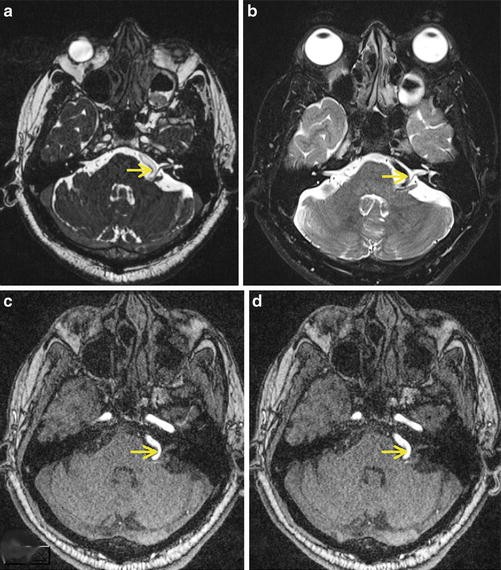

Isolated vertigo especially can occur when there is a stenosis of the caudal or middle portion of the basilar artery (presumably close to the AICA origin) or widespread slow vertebrobasilar flow on MRA. 6 All of these data suggested that isolated episodic vertigo with or without auditory symptom can be the only manifestation of transient ischemia within the vertebrobasilar circulation. 5 I recently reported three patients with anterior inferior cerebellar artery (AICA) infarction who experienced isolated episode of recurrent vertigo, fluctuating hearing loss, and/or tinnitus (similar to Meniere's disease) as initial symptoms 1-10 days prior to the infarction. Subsequent studies 5, 6 also reported similar results: of 29 patients with vertebrobasilar insufficiency, 21% had episodic vertigo for at least 4 weeks as the only presenting symptom. Moreover, 26% had canal paresis to caloric stimulation, indicating a permanent damage to the peripheral vestibular system involving the inner ear or vestibular nerve. Grad and Baloh 1 reported that of patients with vertigo due to vertebrobasilar insufficiency, 62% had at least one isolated episode of vertigo, and in 19% vertigo was the initial symptom. However, recent studies 1, 4, 5 reported contradictory findings. 1 Earlier reports 2, 3 emphasized that isolated vertigo, when present for more than several weeks, is rarely due to vascular events. It is typically abrupt in onset, and usually lasting several minutes. The vertigo is usually accompanied by other neurological symptoms or signs. Transient ischemia within the vertebrobasilar circulation (i.e., vertebrobasilar insufficiency) is a common cause of episodic vertigo in elderly patients. Isolated Episodic Vertigo of Vascular Cause Therefore, this paper provides a concise review of the key features of each cerebellar stroke syndrome focusing on the neuro-otological aspects. For the purpose of prompt diagnosis and adequate treatment, it is imperative to recognize the characteristic patterns of the clinical presentation of each cerebellar stroke syndrome. Furthermore, although small cerebellar infarction generally has a benign prognosis, isolated cerebellar infarction usually results from emboli originating from the heart or great vessels, and recurrent emboli should be treated because a further brainstem infarction due to recurrent emboli can be life-threatening. Large cerebellar infarction can cause brainstem compression, and acute hydrocephalus a few days after the onset of symptoms. Whereas acute labyrinthine disorders are usually benign and self-limited, vascular injuries of the cerebellum may develop a mass effect. Since dizziness/vertigo may occur in isolation without accompanying neurological symptoms or signs, however, a mistaken diagnosis of acute peripheral vestibular disorders might be made. It is usually accompanied by other cerebellar symptoms or signs. Cerebellar infarction is a common cause of a vascular vestibular syndrome and vertigo/dizziness is the most common manifestation of cerebellar stroke. The name "cerebellum" literally means "little brain." From a clinical point of view, the main function of the cerebellum is the coordination of movements. Its effect on brain function is often relatively minor compared to cerebrum. The cerebellum is about one tenth the size of the cerebrum and is located in the posterior fossa, beneath the tentorium cerebelli. This paper provides a concise review of the key features of cerebellar stroke syndromes from the neuro-otology viewpoint. The low incidence of vertigo associated with infarction involving the superior cerebellar artery distribution may be a useful way of distinguishing it clinically from PICA or AICA cerebellar infarction in patients with acute vertigo and limb ataxia. Cerebellar infarction in the territory of the anterior inferior cerebellar artery (AICA) can produce a unique stroke syndrome in that it is typically accompanied by unilateral hearing loss, which could easily go unnoticed by patients. Therefore, physicians who evaluate stroke patients should be trained to perform and interpret the results of the head impulse test.


Recent studies have shown that a normal head impulse result can differentiate acute medial PICA infarction from APV. The most common pseudo-APV is a cerebellar infarction in the territory of the medial branch of the posterior inferior cerebellar artery (PICA). Although vertigo ascribed to cerebellar stroke is usually associated with other neurological symptoms or signs, it may mimic acute peripheral vestibulopathy (APV), so called pseudo-APV. Cerebellar stroke is a common cause of a vascular vestibular syndrome.


 0 kommentar(er)
0 kommentar(er)
